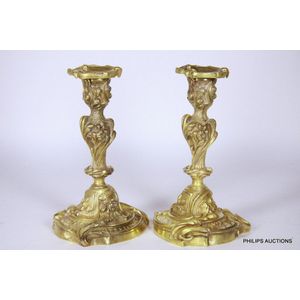Green Art Nouveau Candlesticks with Woman and Lotus Urn
You must be a subscriber, and be logged in to view price and dealer details.
Subscribe Now to view actual auction price for this item
When you subscribe, you have the option of setting the currency in which to display prices to $Au, $US, $NZ or Stg.
- Art Nouveau Period - The Art Nouveau period was a cultural movement that emerged in the late 19th century, and was characterized by its emphasis on natural forms, flowing lines, and a decorative, ornamental style. Art Nouveau was a reaction against the ornate and heavily stylized designs of the previous era, and sought to create a new, more organic aesthetic.
Art Nouveau was characterized by its use of sinuous, curving lines, as well as a focus on natural elements such as flowers, vines, and other organic shapes. Art Nouveau designers sought to create a total work of art, in which every element of a building or object was designed to be harmonious with the overall design.
Some of the most iconic examples of Art Nouveau design include the Paris Metro entrances designed by Hector Guimard, the works of the artist Alphonse Mucha, and the architecture of Victor Horta in Brussels.
The Art Nouveau period was at its peak between 1890 and 1910, but began to decline in popularity by the start of World War I. However, Art Nouveau remains an important influence on design and art to this day, and continues to be celebrated for its emphasis on natural forms and decorative style. - Spelter - Spelter was the name given to an alloy of zinc and brass or copper used in the 19th century for statuary and lighting. It is a brittle bluish-white metal. It was used as a cheap replacement for bronze, but being brittle easily breaks and can't be repaired. When finished it can often be mistaken for bronze, but if discreet a scratch on the base displays shows a greyish colour, the metal is spelter, if a golden colour the metal is most likely bronze.
This item has been included into following indexes:
Visually similar items

Austro-Hungarian silver pair of graduated 13 Loth Havdalah spice containers in the rococo style with a flip top lid. Vienna, 1853, maker Carl Adolf Kohl. Condition, good to fair, some tarnishing, uneven bases, height of tallest -12 cm, weight, 128g

A pair of French cast ormolu candlesticks, late 19th century, the knopped baluster sticks raised upon domed bases, lavishly cast and chased with vegetal and scrolling motifs in the rococo revival manner with Art Nouveau influences, height 20.5 cm

A bronzed spelter lady dancer table lamp with shade C. 1930s, semi-nude with simulated grass skirt (needs rewiring). Height to top of shade 63 cm.

A French 19th century gilded bronze nude maiden holding a dove. 35 cm high.
